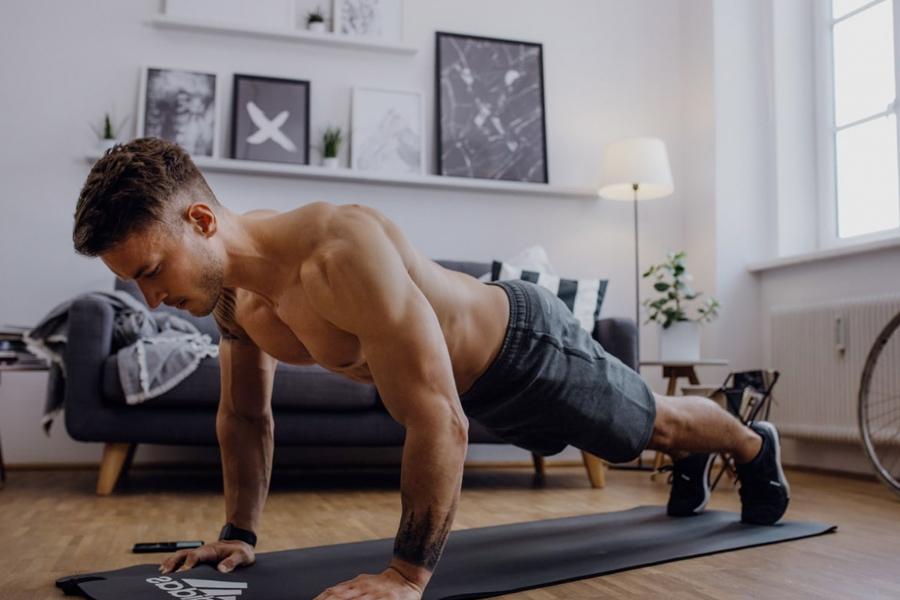
Published:
Readtime: 11 min
Every product is carefully selected by our editors and experts. If you buy from a link, we may earn a commission. Learn more. For more information on how we test products, click here.
When originally learning how to do push-ups, most of us are shown a method that’s fairly straightforward, but also slightly incorrect. As a result, even your most ardent fitness freak might very well be practising improper push-up form. To be completely honest, we ourselves didn’t really know how to do a truly proper push-up until researching for this very article!
There’s a pretty good chance that you’re likewise demonstrating incorrect push-up form. That would make you part of the overwhelming majority. In fact, it’s been estimated that up to 95% of people don’t know how to do a proper push-up, which is an astounding percentage. Apparently, there’s far more to this common bodyweight exercise than first meets the eye.
To be clear, we’re not suggesting that you don’t know how to do push-ups. On the contrary, most people practice what might be best described as a near-proper push-up form. That is, they assume a general plank position, put their arms around shoulder-width apart, and bend to about 90 degrees at the elbows as they move down and then push up. Sounds simple enough, right? Well, not exactly.
As it turns out, there are subtle variations between the incorrect and correct push-up form, which can have significant outcomes in terms of actual strength building. This is quite important because you figured out how to do push-ups in the first place so that you could build upper body strength. What good is it then if this occasionally gruelling exercise isn’t doing what it’s supposed to do? Not much good at all.
Today, we put misconceptions and improper push-up forms to rest. That is, we’re going to teach you how to do push-ups all over again. Use the following method and you might actually have some serious muscles to show for it. Here’s how to do a proper push-up.
The Correct Push-Up Form
Are you ready to practice proper push-up formation? There are the push-ups most people do and then proper push-ups, the latter of which are more nuanced and effective by comparison. Thankfully, making the transition requires just a few tweaks. Here’s how to do push-ups the right way:
1. Assume the Proper Push-Up Position
Before you even perform that first rep, you’ll need to put your body in the proper position. Here’s how:
- Get on the ground and set your hands just a tad wider than shoulder-width apart.
- Your hands should be even with your chest and angled in a manner that’s most comfortable to you, though most people point them straight forward.
- If you suffer from wrist pain or have poor wrist flexibility, consider using push-up handles.
- Set up your feet in a position that feels comfortable to you, meaning you can keep them shoulder-width apart or even have them lightly touching one another.
- As a general rule of thumb: the wider the distance between your two feet, the more stable your push-ups will be.
- Ultimately, you should aim for a perfect plank formation, with an invisible straight line running from the top of your head through to your core and, ideally, all the way to your heels.
- Your butt should be even with the rest of your body, meaning it shouldn’t be up in the air or low to the ground.
- If you’re struggling to get into proper push-up formation, try tightening your butt and abs and thereby activating your core.
- Consider recording your actions so as to ensure that your body is in a straight line.
- Your head should be looking slightly forward as opposed to straight down.
- When your head is in the right position, your chin will touch the ground and not your nose.
- If you’re more comfortable looking downward as opposed to slightly forward, feel free to do so while making sure your body stays in a straight line.
- In the starting position, your arms should be completely straight and supporting your weight.
- You’re now ready to perform a proper push-up.
2. Executing a Proper Push-Up
You’ve assumed the starting position and now it’s time to crank out some reps. Here’s how to do a proper push-up:
- Keep your arms straight, your butt clenched, your core tightened, and your elbows as even with the floor as you can.
- Gradually lower yourself until each elbow is at a 90-degree angle or less.
- Try to go all the way down until either your chest or nose or chin lightly touches the floor, inhaling along the way.
- Once your chest or nose or chin is touching the floor, hold for a brief pause before thrusting yourself back into the starting position, exhaling as you go.
- Prevent your elbows from flying outward during each rep and keep them somewhat close to your body.
- Maintain a steady and consistent formation throughout each rep.
- Perform as many reps as you can until you feel that you can no longer maintain the plank-like formation or prevent your elbows from pointing away from you.
Congratulations! You’ve just learned how to do push-ups the proper way.
What Are the Benefits of Correct Push-Ups?
By executing correct push-up formation each and every time, you’ll be building actual strength in your triceps, pectorals, deltoids, glutes, and core (amongst other areas). What’s most important is that you focus on quality over quantity. That means cranking out as many proper push-ups as you can and not wasting any time on a single improper push-up. If you perform just five or six correct push-ups before giving up, so be it. The number will climb as you progress.
Why are Push-Ups Difficult?
A push-up in pretty much any form (i.e. improper or not) doesn’t look like it should be all that hard to pull off, and yet many people struggle to execute them. Even those of us who both feel and look relatively strong might occasionally fail to perform more than say five or ten push-ups at a time. Does this mean we aren’t as strong as we thought?
The answer is that you might not be as strong as you thought in specific areas, namely your chest, triceps, and core. Like planks, push-ups challenge these areas more than any other while furthermore relying on things like hip stability. A strong core is of particular importance because it’s where strength and balance collide.
As with all fitness, there’s also a mental aspect to push-ups. That means you might need to rid yourself of self-defeating notions before taking to the nearest mat or floor. For example, people who have struggled with push-ups in the past might be convinced that they’re simply not any good at the bodyweight exercise, even if those same people have built up strength in the meantime.
Should you be experiencing any sort of mental blockage or innate aversion to push-ups, it’s important that you challenge yourself by doing them anyway. You might be surprised at what you discover. Of course, when you do take to the floor, you’ll want to make sure you’re practising proper push-up form.
6 Different Types of Push-Ups
Once you’ve mastered traditional push-up formation and built strength where it counts, you might want to branch out into more advanced territory. Should you make this journey, you’ll soon discover that there are various types of push-ups, a number of which will truly put your muscles to the test. Only when you’re right and ready should you consider the following variants:
1. Diamond Push-Up
This one works your arms and chest far more than the standard push-up. Naturally, it will change the direction of your elbows. Here’s how to execute:
- Assume the starting push-up position.
- Move your hands together beneath your chest so that your pointer fingers and thumbs touch, creating a diamond shape.
- Perform a proper push-up and repeat.
2. Clap Push-Up
This one is not for the faint of heart…or wrist, for that matter. Nevertheless, here’s how to do it:
- Assume the starting push-up position.
- Execute a correct push-up, thrusting up with enough force to slightly launch yourself off the ground.
- Clap your hands while in mid-air.
- Land in the starting position and repeat.
3. Scorpion Push-Up
Like virtually every variant, this one’s not for beginners. What remains crucial is that you maintain a proper straight-line formation when you perform it. Here we go:
- Assume the starting push-up position.
- Lower yourself, hold for a brief moment, and raise one leg off the floor.
- Bend your knee towards your back and slightly to the side, keeping your chest and core in a straight line.
- Thrust upward and return the leg to the starting position.
- Either switch legs on the next rep or switch legs after each set.
4. Knuckle Push-Up
This one’s as brutal as it sounds and commonly practiced by professional fighters. Bring out your inner MMA warrior by doing the following:
- Assume the starting push-up position.
- Form a knuckle with each hand.
- Perform proper push-ups on your knuckles instead of your palms.
5. Fingertip Push-Up
Like the knuckle push-up, this one is fairly self-explanatory. Remember to maintain the proper push-up formation at the core and elbows. Here we go:
- Assume the starting push-up position.
- Raise each hand onto its fingertips.
- Perform proper push-ups on your fingertips instead of your palms.
6. One-Armed Push-Up
So you’ve absolutely mastered the proper push-up, have you? You must have if you’re ready for this one. Here’s how to do it:
- Assume the starting push-up position.
- Spread your legs wider apart than you normally would, keeping your core straight.
- Put one arm behind your back and bring the remaining arm in closer to your chest.
- Perform a proper push-up on the remaining arm.
When Should I Do Push-Ups?
Odds are you already practice some sort of workout routine, which begs the question: when and how should you bring push-ups into the fold? The answer depends on your level of experience. For instance, if you’re in the early stages of strength building, then bodyweight exercises will help improve upon muscle growth and balance alike. In that scenario, you should incorporate push-ups into your regimen.
Should you be further along in your progress, there’s still plenty of room for push-ups. Whether that means performing them as a warm-up or casual bodyweight exercise depends on the parameters of your particular lifestyle. If you want to incorporate them into an already intense program, you might want to employ advanced formations like the diamond or knuckle.
General FAQ
True beginners might want to keep their knees on the ground when first learning how to do push-ups, though this won’t necessarily build much strength. Your best bet is to focus on proper formation over anything else, thereby maximising the effectiveness of each push-up. Just a few correct push-ups will be far more beneficial than say 20 incorrect ones.
The best way to improve upon your push-up form is to assume the plank position and maintain a straight line formation throughout. Your butt should be even with the rest of your body, your elbows aligned with the floor, and your head (ideally) facing slightly forward.
If you’re struggling to pull off just one proper push-up, it could be that you lack strength in areas like your triceps and core. You might also lack a certain amount of balance and stability. Mental inhibition is another potential factor.
Being a bodyweight exercise, even proper push-ups will only get you so far. After you’ve built up a certain amount of muscle, it’s time to move on to a more rigorous workout routine.
You’ll also like:
10 Best Chest Exercises for Men
10 Best Core Exercises for Men
16 Best Calf Exercises and Workouts for Men































Comments
We love hearing from you. or to leave a comment.